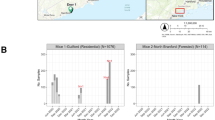Abstract
Handling a rodent disease outbreak in a facility can be a challenge. After the University of Colorado Denver Office of Laboratory Animal Resources enhanced its sentinel monitoring program, > 90% of the animal colonies housed in a vivarium at the Anschutz Medical Campus (with an area of 50,000 net ft2), serving the labs of > 250 principal investigators, tested positive for multiple infective agents including mouse parvovirus, fur mites, pinworms and epizootic diarrhea of infant mice. The authors detail the process by which they planned and executed a shutdown and a decontamination of the facility, which involved the rederivation or cryopreservation of > 400 unique genetically modified mouse lines. The authors discuss the aspects of the project that were successful as well as those that could have been improved.
This is a preview of subscription content, access via your institution
Access options
Subscribe to this journal
We are sorry, but there is no personal subscription option available for your country.
Buy this article
- Purchase on Springer Link
- Instant access to full article PDF
Prices may be subject to local taxes which are calculated during checkout



Similar content being viewed by others
References
Baker, D.G. Natural pathogens of laboratory mice, rats, and rabbits and their effects on research. Clin. Microbiol. Rev. 11, 231–266 (1998).
Jacoby, R. & Ball-Goodrich, L. in The Mouse in Biomedical Research, Volume 2: Diseases 2nd edn. (eds. Fox, J.G. et al.) 101–102 (Elsevier, Burlington, MA, 2007).
McKisic, M.D., Paturzo, F.X. & Smith, A.L. Mouse parvovirus infection potentiates rejection of tumor allografts and modulates T cell effector functions. Transplantation 61, 292–299 (1996).
Ball-Goodrich, L.J., Hansen, G., Dhawan, R., Paturzo, F.X. & Vivas-Gonzalez, B.E. Validation of an enzyme-linked immunosorbent assay for detection of mouse parvovirus infection in laboratory mice. Comp. Med. 52, 160–166 (2002).
Watson, J. Unsterilized feed as the apparent cause of a mouse parvovirus outbreak. J. Am. Assoc. Lab. Anim. Sci. 52, 83–88 (2013).
Richardson, L. Using multiport euthanasia devices: how to spend less time doing the least pleasant part of your job. Tech Talk 17, 4 (2012).
Czarneski, M.A. & Lorcheim, K. A discussion of biological safety cabinet decontamination methods: formaldehyde, chlorine dioxide, and vapor phase hydrogen peroxide. Appl. Biosafety 16, 26–33 (2011).
Turner, D.E., Daugherity, E.K., Altier, C. & Maurer, K.J. Efficacy and limitations of an ATP-based monitoring system. J. Am. Assoc. Lab. Anim. Sci. 49, 190–195 (2010).
Redig, A.J. & Besselsen, D.G. Detection of rodent parvoviruses by use of fluorogenic nuclease polymerase chain reaction assays. Comp. Med. 51, 326–331 (2001).
Macy, J.D., Paturzo, F.X., Ball-Goodrich, L.J. & Compton, S.R. A PCR-based strategy for detection of mouse parvovirus. J. Am. Assoc. Lab. Anim. Sci. 48, 263–267 (2009).
Compton, S.R., Paturzo, F.X., Smith, P.C. & Macy, J.D. Transmission of mouse parvovirus by fomites. J. Am. Assoc. Lab. Anim. Sci. 51, 775–780 (2012).
Author information
Authors and Affiliations
Corresponding author
Ethics declarations
Competing interests
The authors declare no competing financial interests.
Rights and permissions
About this article
Cite this article
Leszczynski, J., Wallace, M., Tackett, J. et al. Shutting down a working vivarium for decontamination. Lab Anim 43, 283–290 (2014). https://doi.org/10.1038/laban.567
Received:
Accepted:
Published:
Issue Date:
DOI: https://doi.org/10.1038/laban.567



